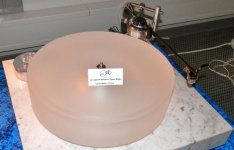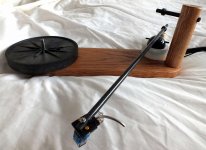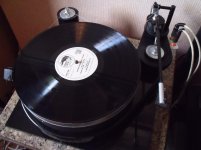OK, very intriguing project guys. Anyone done listening tests plus and minus the damping fluid? and what did you think?
Seems to me most of this is working to harmlessly dampen resonances in the tonearm as well as having an effect on tracking. So rather than wood I will probably have first go at it with a sand filled carbon rod. Hollow wood would be interesting to try but more difficult to make/access?
Seems to me most of this is working to harmlessly dampen resonances in the tonearm as well as having an effect on tracking. So rather than wood I will probably have first go at it with a sand filled carbon rod. Hollow wood would be interesting to try but more difficult to make/access?
Without the fluid, the arm swings completely freely and uncontrollably like a kid swinging from a rope on a tree. Golfball is constrained only in the Z direction by the thread. Movement in X & Y directions is controlled by the weight of the golfball hanging on the thread and the damping fluid.
Just been assembling my turntable and arm now (without fluid) and the arm is all over the place - may have to wait until weekend before I install fluid & set up cartridge. Set up should be interesting because unlike a fixed pivot, this'll go wherever you drag it.
If you think of the forces involved, gravity is pulling the golfball vertically below the suspension point but the record is trying to pull the tonearm around with it. So the golfball will be pulled slightly away from vertical in the direction of the stylus.
Just been assembling my turntable and arm now (without fluid) and the arm is all over the place - may have to wait until weekend before I install fluid & set up cartridge. Set up should be interesting because unlike a fixed pivot, this'll go wherever you drag it.
If you think of the forces involved, gravity is pulling the golfball vertically below the suspension point but the record is trying to pull the tonearm around with it. So the golfball will be pulled slightly away from vertical in the direction of the stylus.
😱😱😱 great work !
what wood is ?
For the headshell I don't know what kind of wood I used. A friend brought it back form Peru. It is very hard and heavy. For the other parts I used Padauk, for the ball is used Zebrawood.
Without the fluid, the arm swings completely freely and uncontrollably like a kid swinging from a rope on a tree. Golfball is constrained only in the Z direction by the thread. Movement in X & Y directions is controlled by the weight of the golfball hanging on the thread and the damping fluid.
Just been assembling my turntable and arm now (without fluid) and the arm is all over the place - may have to wait until weekend before I install fluid & set up cartridge. Set up should be interesting because unlike a fixed pivot, this'll go wherever you drag it.
If you think of the forces involved, gravity is pulling the golfball vertically below the suspension point but the record is trying to pull the tonearm around with it. So the golfball will be pulled slightly away from vertical in the direction of the stylus.
Hi russc,
It has been a long time since I had a WTA but still have a soft spot for the design. Mine was a close clone of the original WTA. My biggest complaint was that the Z direction was free to move around and took so long to settle after moving the arm. I have a suggestion and would like to see someone try it out. Put an iron/steel pole piece in the bottom of the golf ball and a neodymium magnet on the bottom of the silicone cup. You could use 2 magnets attracting each other for greater force. I've mentioned this idea several times on this forum, but so far nobody has picked up on it. Give it a go and report please.
BillG
I made one a couple years ago and that's exactly what I did, I also wasn't content with the degree of freedom of movement. I loved it, the best diy design I've tried by far (I've done unipivots and air bearings and a schroeder design as well). I disassembled it when I switched tables and recently out together another without the magnet but haven't had a chance to try it out yet. To me the sound was detailed and delicate but also had excellent bass and an excellent sense of "control", if that's the right word, just made everything sound effortless. Not sure if I'll notice the same without the magnet but I'll try it and let you know. I also found that with the damping fluid there was a great deal of flexibility regarding cartridge matching.
A magnet is an interesting way to get rid of the silicone fluid, but it is not a damper, and its resistance as you describe it drops off as the force resisting it increases. Perhaps repelling magnets could be placed about it to give more of a spring like character. It would be interesting to try.Hi russc,
It has been a long time since I had a WTA but still have a soft spot for the design. Mine was a close clone of the original WTA. My biggest complaint was that the Z direction was free to move around and took so long to settle after moving the arm. I have a suggestion and would like to see someone try it out. Put an iron/steel pole piece in the bottom of the golf ball and a neodymium magnet on the bottom of the silicone cup. You could use 2 magnets attracting each other for greater force. I've mentioned this idea several times on this forum, but so far nobody has picked up on it. Give it a go and report please.
BillG
Yes, I can imagine there would be a lot of pendulum action, so my idea of a control was not so good. Better would be a low viscosity solution, such as water, or low viscosity silicone. I just got into this and am going to put something together. I love the recent Well Tempered Turntable philosophy of Bill Firebaugh, which uses ingenuity to replace precision machinery. I wish him well but I think his inventions should be enabling great turntables at dramatically lower prices due to this fact. Perhaps it is a feature of "vinyl" being a super niche market these days, but it will be hard for people to swallow a hanging golf ball and tensioned delrin bearings as being worth near $4,000. And that is precisely why DIY threads like this are excited about it all.
In reading about the Well Tempered Tonearm, I was somewhat taken aback by what I think was referred to here as the unfixed Z axis (movement in line with the tonearm and the tangent of the groove at the stylus). I imagined that congested passages versus quiet passages would track at different rates due to this feature. But surprisingly no one has mentioned this as a real world problem. Interestingly, the Well Tempered site is now advertising a LTD Tonearm only product that has been further modified to lower the pivot point on the golf ball such that this Z axis problem would be self correcting. Not yet sure how one would calculate the best pivot point to neutralize this effect but this is a genius observation IMO that gives another parameter with which to experiment.
A magnet is an interesting way to get rid of the silicone fluid, but it is not a damper, and its resistance as you describe it drops off as the force resisting it increases. Perhaps repelling magnets could be placed about it to give more of a spring like character. It would be interesting to try.
Yes, I can imagine there would be a lot of pendulum action, so my idea of a control was not so good. Better would be a low viscosity solution, such as water, or low viscosity silicone. I just got into this and am going to put something together. I love the recent Well Tempered Turntable philosophy of Bill Firebaugh, which uses ingenuity to replace precision machinery. I wish him well but I think his inventions should be enabling great turntables at dramatically lower prices due to this fact. Perhaps it is a feature of "vinyl" being a super niche market these days, but it will be hard for people to swallow a hanging golf ball and tensioned delrin bearings as being worth near $4,000. And that is precisely why DIY threads like this are excited about it all.
In reading about the Well Tempered Tonearm, I was somewhat taken aback by what I think was referred to here as the unfixed Z axis (movement in line with the tonearm and the tangent of the groove at the stylus). I imagined that congested passages versus quiet passages would track at different rates due to this feature. But surprisingly no one has mentioned this as a real world problem. Interestingly, the Well Tempered site is now advertising a LTD Tonearm only product that has been further modified to lower the pivot point on the golf ball such that this Z axis problem would be self correcting. Not yet sure how one would calculate the best pivot point to neutralize this effect but this is a genius observation IMO that gives another parameter with which to experiment.
Perhaps I was not explicit in my first note here. I do not suggest getting rid of the silicone fluid or going to a lighter viscosity fluid. Keep the original thick silicone fluid and add the magnet to eliminate as much as possible the wandering z axis.
Rgds,
BillG
Hi Folks
After building several arms, I have never had any issues with 'wandering'- are people using the correct spec. fluid? Anything less than 100,000 cst would perhaps not offer the correct control needed.
Chris
After building several arms, I have never had any issues with 'wandering'- are people using the correct spec. fluid? Anything less than 100,000 cst would perhaps not offer the correct control needed.
Chris
Hi Folks
After building several arms, I have never had any issues with 'wandering'- are people using the correct spec. fluid? Anything less than 100,000 cst would perhaps not offer the correct control needed.
Chris
Hi Chris, In actual operation I never had any problem with "wandering" per se. What I did experience was having the flat disk golf ball predecessor go off center in the silicone cup if I lifted the arm too high or moved it off center too far. It would then bump into the side of the cup. If I waited looooong enough it would settle into its proper location. It was possible to forcibly centralize the disk which I did. On general principles I was not pleased with this feature. The length of time to settle was determined by the viscosity of the silicone (100,000cst) Very thick. BTW I was the member who initially provided this value to the forum. I just didn't like the ambiguity of the whole thing. In spite of this it was the best arm for me until the 2 ball 4 rail LT came along.
Cheers,
BillG
Tried first run of new turntable (based on Bushman) with WTL arm. Motor is a (ex-printer) stepper with Arduino & DSPIN microstepping driver. Temporary drive is Meccano pulley & fishing line. First vinyl I've played without rumble (previous turntable was Project1 - enough to put anyone off vinyl). Something to look forward to after my holidays.
Perhaps I was not explicit in my first note here. I do not suggest getting rid of the silicone fluid or going to a lighter viscosity fluid. Keep the original thick silicone fluid and add the magnet to eliminate as much as possible the wandering z axis.
Rgds,
BillG
I think you have the best idea. That is why shock adsorbers have both springs and dampers to provide compliance with bumps. My reference was simply to do a controlled experiment to validate that theory reflects reality, and was not suggested as an endpoint. But I really like the idea of a magnet implanted into the bottom of the golf ball to better fix the rotational axis. Personally, after looking into solutions for damping tonearm vibrations I prefer the Townshend dampening at the cartridge end over the WT solution here, inspite of it being messy. Since they both involve maintaining reservoirs of viscous silicone oil maybe I should just do both!
Last edited:
Does this 2013 Munich audio show picture look familiar? I get the feeling there were some patent fights over this design 🙂
Attachments
Last edited:
Can anyone confirm required viscosity of silicon fluid? I have built the golf ball design WTL and have 100,000cst fluid (as post 222). It's like syrup on a cold day and arm seems over-damped to me. Currently arm drops very slowly to horizontal, if I add 2g weight to headshell it will slowly lower. Just want to be sure all is ok before I try out.
Turntable plinth is based on Bushman as much for appearance as anything.
Turntable plinth is based on Bushman as much for appearance as anything.
Attachments
Hi
That's the viscosity I use and that's what's recommended. Works just perfectly on the several arms I have made.
Regards
Chris
That's the viscosity I use and that's what's recommended. Works just perfectly on the several arms I have made.
Regards
Chris
I have an LTD and while it does not specify the viscosity it looks to be about 100,000 cps when I compare it to my other silicone oil stashes. One thing to note is that it is recommended that the golf ball is only 1/3 suspended in the oil. Given the ball is already cut in half I think that means roughly 1/4-5/16" deep in the oil. That will probably fix your apparent over damping.
Thanks for answers. I've made the full ball version. I have downloaded WTL manual 2009 (full golf ball) which states halfway up ball (= 21mm) and WTL 2014 manual for later half ball version which states 1/3 up half-ball (= 7mm). Clearly the early version must have used a much lighter fluid. Easy enough to scoop some out but might be better to maintain depth and use a lighter fluid for my full ball arm.
WTL Tribute
Hi All
As you can see from the enclosed, I have now opted for the 'half ball' approach. I think it looks neater but also makes the fabrication easier- no golf ball drilling needed. It also makes it easier to ensure the arm is at true right angles to the cradle. As recommended by WTL I immerse the ball a third of the way up what would have been a full golf ball.
Hi All
As you can see from the enclosed, I have now opted for the 'half ball' approach. I think it looks neater but also makes the fabrication easier- no golf ball drilling needed. It also makes it easier to ensure the arm is at true right angles to the cradle. As recommended by WTL I immerse the ball a third of the way up what would have been a full golf ball.
Attachments
Thanks for answers. I've made the full ball version. I have downloaded WTL manual 2009 (full golf ball) which states halfway up ball (= 21mm) and WTL 2014 manual for later half ball version which states 1/3 up half-ball (= 7mm). Clearly the early version must have used a much lighter fluid. Easy enough to scoop some out but might be better to maintain depth and use a lighter fluid for my full ball arm.
Agreed, this is not rocket science. It is a matter of viscosity and the lever arm/surface area it sees. Greater depth should give a tiny bit of greater consistency. One point I will make. Having examined the WT design I am impressed with it enabling a CG above its hinge point. This rare feature is the opposite of your typical unipoint abomination. It creates a favorable dynamic balance. When record warps drop the stylus it responds with a higher tracking force, and when the warp raises the stylus it instead lowers the tracking force. It responds as the situation demands. If I see your photo correctly you have defeated this feature by using a low hanging counterbalance (as has ChrisG139 above). Not sure but that is what I appear to be seeing.
Last edited:
- Status
- Not open for further replies.
- Home
- Source & Line
- Analogue Source
- My DIY WTL Tonearm




